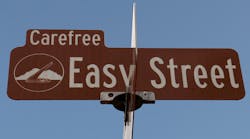Want a B.S. Job? Try Strategic Sourcing in OEM Purchasing
Per the formal definition, an OEM having a strategic sourcing function makes a lot of sense. Why? Because it is important to select suppliers that will increase your own company’s competitiveness.
My issue with strategic sourcing is that all too often its primary—or sole—criteria for supplier selection is piece-price; i.e., sourcing with the supplier offering the lowest. Let me show how this strategy can negatively impact OEM competitiveness based on three personal experiences.
Example Number 1: Building Short
Having a reputation as a successful materials manager, I was once asked to take a leave from my corporate job and fill in that role at one of our non-U.S. factories. The factory had another person in mind for the permanent position, but he wouldn’t be available for about six months. At the time, this factory was reporting some of the supply chain performance results in the corporation and consequently, when I was offered the job, I was told it would be “a breeze.”
I was surprised when I arrived at the factory to see a massive amount of what appeared to be finished product out in the yard. Hmm. What was it doing there and why hadn’t it shipped? A red flag immediately popped up in my mind.
During my introduction to the factory—given by its general manager—I asked about that pre-built inventory and was surprised to learn that it had been built short; i.e., missing primarily purchased parts. When I asked the general manager why his factory built short, he replied that “if we didn’t, we wouldn’t be building much at all.”
Partially built machines, of course, all have to be reworked outside of normal production processes prior to shipment. Because of this, they are exposed to higher risk of quality defects.
When I got settled in the purchasing department, the first question I asked is:
“What’s going on with the purchased part shortfall—aren’t you supposed to have one of the top on-time delivery performing supply bases in the corporation?”
In digging into this, I found that quite often, there were multiple purchased parts missing on the partially built product but—and this is an important but—only the first defective or late part was counted in the factories’ purchasing metrics. Why? Because the reasoning went that subsequent late or defective parts weren’t holding up production until the first one became available! And often, by the time that one was received, the others had come in and consequently classified as on-time. Hmm. How I dealt with this is another (long) story, but it should give you a feel for how the factory’s previous material manager gamed the system to make his factory’s supplier performance metrics look good.
Read more of Paul Ericksen's supply chain management articles
This purchasing department had a single person focusing on strategic sourcing. He was a young fellow with high aspirations. The factory was one of those old-time shops where if you didn’t punch the factory-supervision ticket, you didn’t progress up the organizational ladder. Consequently, the guy wanted his next assignment to be in shop supervision. The directive he was working under was to “re-source purchased product with lower piece-price suppliers.” He had been told that if he was successful in this, he would have earned his way into the next open factory supervisory position.
Anyway, I soon discovered that the parts my strategic sourcing person had sourced represented the bulk of the ones that product was being built short of. In other words, we were getting lower pricing, but we weren’t getting usable parts on time to support our production schedules. In addition, it was the buyer who was taking the heat for this. In this case, strategic sourcing cost our factory significantly more than the piece-price advantage gotten from its strategic sourcing activity.
I immediately started working on this issue to try right the situation before my successor arrived, which I was able—for the most part—to do.
Example # 2- The Overseas Sourcing Performance Management Metric
At one time, the company I worked for had a new VP of Purchasing who wasn’t happy with the relatively low percentage of parts being sourced overseas, so he put out new supply management performance management metric, namely:
Going forward, 33% of newly sourced parts must be sourced in low-wage countries.
Hmm. His opinion was that factories were awarding business to domestic suppliers due to an innate resistance to sourcing overseas. Instead—as those of us at the factory level understood—we had been sourcing domestically because we found better-performing suppliers in the U.S, particularly ones that were positioned to respond to short-fuse changes in schedule. This capability was important since most of our company’s products were seasonal with short sales windows. But the new VP had never worked in purchasing before and in my mind was primarily was driven by what he saw other corporations doing. In other words, I felt he had a case of the lemming-complex.
What followed was almost blasphemous.
In response to his decree, one of our other divisions re-sourced all of their requirements from a long-term domestic supplier—that had recently been named Supplier of the Year—to a foreign supplier. Talk about a supplier excellence award being a curse. This lost business represented over 25% of that supplier’s total production. Because of this, it put their entire business at risk. An unintended consequence of this was jeopardizing the business that other divisions had with the supplier.
I confronted my counterpart at that other division and found out that the re-sourcing wasn’t due to performance or pricing concerns; i.e., the current U.S.-based source had the same or lower pricing than the overseas supplier as well as a sterling record of quality and on-time delivery. Rather, the product category this supplier participated in—machined parts—was deemed as the easiest one to re-source overseas, and in doing so, his division would hit the new 33% offshore sourcing performance goal.
In order to protect the continuity of my division’s supply, I helped the supplier replace most of the lost business—a move that didn’t endear me with the new VP, but did result in a price reduction and better supplier performance!
Example #3 - The MBA Project
I had an ongoing task of trying to make the point to the powers-that-be that product demand characteristics should be considered in making sourcing decisions. For instance, with seasonal products having short selling seasons, forecast error is typically higher, and revising the schedule to address off-target forecasts was difficult, if not impossible, with a long supply chain. When I presented this to our VP of purchasing—the same one cited above—he took it as just another effort to avoid sourcing overseas in spite of the actual financial business case I had presented. Lemming complex, indeed!
At this time, our company was trying to increase the number of people in supply management with MBAs. At the suggestion of one of my colleagues at another factory, one of his MBA-pursuing buyers investigated—for his MBA thesis—the question of whether overseas sourcing made business sense. Given the new VP’s directive regarding sourcing overseas, I had concerns that the findings would be biased. Guess what? They were.
This guy’s thesis concluded that sourcing overseas based on piece-price was the way-to-go regardless of all other factors. I guess this shouldn’t have been a surprise to anyone. Since this was the position our new purchasing VP, was pushing he gave the buyer the opportunity to present his findings directly to the CEO. And the buyer ended up getting a promotion.
The end result was that his thesis was one of the factors that cemented sourcing overseas at our company. About that same time I took early retirement from this company and moved on. I knew it was time to go.
So what can be concluded from the above three examples? As long as companies view purchasing’s sole contribution to the bottom line to be lower piece-prices—no matter the intent of the initiative—the strategic sourcing function will be subverted to focus on lowest piece-price as the primary source selection criteria. Anyone can find a source that will quote lower piece-prices. If this is the manner in which the strategic forcing function at your company operates—and you want an easier job—try to get a transfer to that group.
Paul Ericksen is IndustryWeek’s supply chain advisor. He has 40 years of experience in industry, primarily in supply management at two large original equipment manufacturers.




